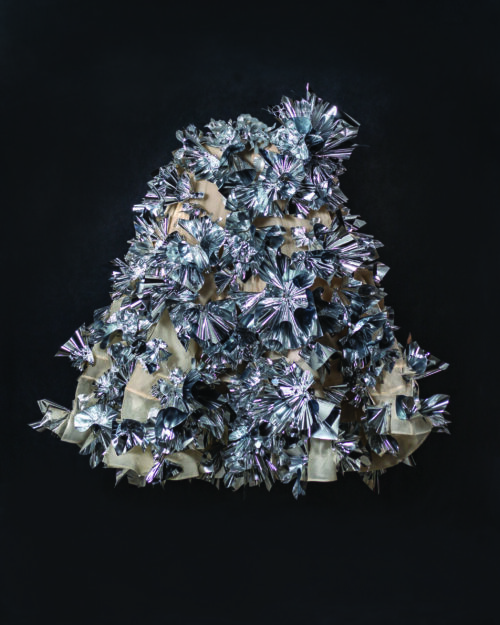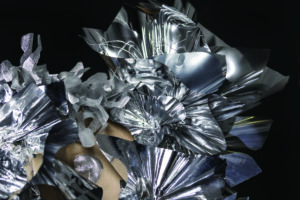By SCOTT MCKIE B.P.
One Feather Asst. Editor
A Cherokee artist is pushing her artwork into the future. Luzene Hill, a member of the Eastern Band of Cherokee Indians, has a piece included in the “Future Imaginaries: Indigenous Art, Fashion, Technology” show running now at the Samuel & Minna Grodin Gallery at The Autry Museum of the American West in Los Angeles, Calif.
Hill commented, “I’m honored to have my work in this exhibit! It’s an important, forward-facing show that presents a dynamic collection of art and imagination. It will be up until June of 2026, which is a bonus – as the work will be seen by more people over a longer period of time.”

Luzene Hill, a member of the Eastern Band of Cherokee Indians, has a piece entitled “REVV” included in the “Future Imaginaries: Indigenous Art, Fashion, Technology” show running now at the Samuel & Minna Grodin Gallery at The Autry Museum of the American West in Los Angeles, Calif. (Photos by Carmen Arkansas Nations/Clay Nations Photography)
According to information from The Autry Museum of the American West, “’Future Imaginaries’ explores the rise of Futurism in contemporary Indigenous art as a means of enduring colonial trauma, creating alternative futures, and advocating for Indigenous technologies in a more inclusive present and sustainable future…by intermingling science fiction, self-determination, and Indigenous technologies across a diverse array of Native cultures, ‘Future Imaginaries’ envisions sovereign futures while countering historical myths and the ongoing impact of colonization, including environmental degradation and toxic stereotypes.”
For the exhibit, Hill made a special piece. “I created a new piece, ‘REVVV’, based on a cape motif I had used previously for ‘Revelate’ and ‘Retribute’. This cape is ankle length, constructed of silk organza, and covered with various size Mylar bursts. I then collaged silver tissue lamé figures and symbols to the flesh tone organza background. Finally, I added tissue lamé clusters of female forms to add texture, nuance, and depth.”
She added, “The curators asked me to contribute a cape, ‘like the Revelate capes’ for the show. Since I was making new work, I wanted to do more than duplicating earlier pieces. REVVV presents a more assertive and specific image – denoting a futuristic Super Heroine bursting forth, cloaked in Indigenous matriline power.”
When asked what message she hopes her piece conveys to the world, Hill responded, “Future Indigenous ascendance arises from a path of pre-contact constructs, worldviews uncorrupted by colonial patriarchy. Social systems that existed on this continent prior to 1492 were predominantly matrilineal and matrilocal. That structure promoted equilibrium and balance; cultures in which women had agency, power, and position developed from those principles.”
Regarding themes in her work, Hill noted, “My work often addresses violence against women, especially violence against Indigenous women. That focus has led me to research matrilineal cultures, as well as more ancient and primitive expressions of female images and power. I’m currently intrigued by symbols found in caves, signifying females – their presence, their roles, and their sacred status. I’m developing new work using those motifs, as I find the more primitive the source, the more universal the concepts seem to be.”
Hill is always pushing herself artistically. “Having the opportunity in 2021 to ‘activate’ Jeffrey Gibson’s monumental sculpture, ‘Because When You Enter My House, It Becomes Our House’, at deCordova Sculpture Park, was a big influence on me. The exceptional opportunity to collaborate with Jeffrey pushed my vision, as well as working on a large scale out of doors, beyond the confines of white cube gallery space. A few months after my experience at deCordova, I activated a restored tobacco barn during my residency at Township 10, Mars Hill, N.C. That work, entitled ‘Smoke and Mirrors’, was about the plunder of Indigenous natural resources and belief systems. I never would have attempted ‘Smoke and Mirrors’ had I not worked with Jeffrey at deCordova.”
 Her work continues to evolve, grow, and expand. “I’m doing more performance in my installations, working on pieces for outdoor public art as well as in gallery spaces, and thinking, working, on a grander scale. I’ve gone deeper into the subject of gender violence, beyond simply presenting numbers and statistics (data), to investigating the ‘why’ of that phenomenon. Patriarchy is clearly the ‘why’.”
Her work continues to evolve, grow, and expand. “I’m doing more performance in my installations, working on pieces for outdoor public art as well as in gallery spaces, and thinking, working, on a grander scale. I’ve gone deeper into the subject of gender violence, beyond simply presenting numbers and statistics (data), to investigating the ‘why’ of that phenomenon. Patriarchy is clearly the ‘why’.”
The “Future Imagninaries” exhibit deals with envisioning sovereign futures. When asked how she views this, Hill commented, “When I moved back to Cherokee two years ago, my goal was to live on the Qualla Boundary, not just nearby. This choice was both an emotional and political decision. I wanted to occupy sovereign tribal land, to support tribal sovereignty by my presence, and to perpetuate my ancestors’ occupation of our homelands.”
She added, “Sovereignty is both a legal construct and a personal one. Tribal sovereignty is power. Individual sovereignty is power. Moving into the future, Indigenous sovereignty depends on each person asserting their agency, and our tribal communities continuing to find new ways to use that power to grow and prosper.”
For more information on this exhibit, visit: https://theautry.org/exhibitions/future-imaginaries. To view more of Hill’s artwork, visit: https://luzenehill.com.





